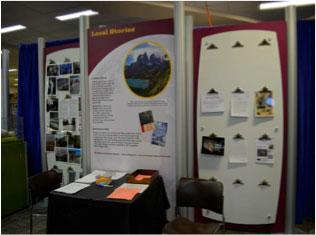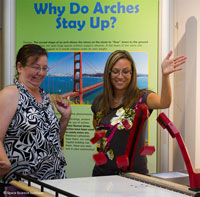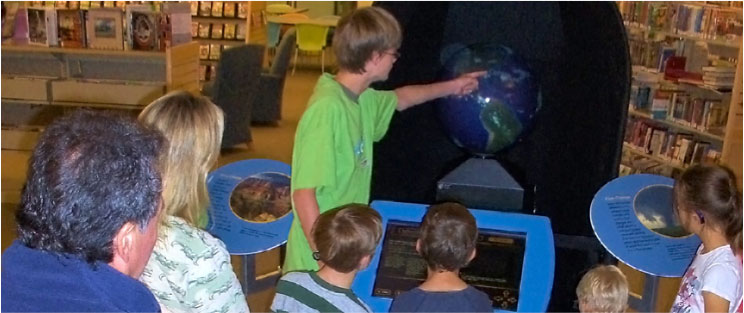STAR_Net
A hands-on learning program for libraries and their communities (or STAR_Net) is a national program led by the Space Science Institute’s National Center for Interactive Learning (NCIL) nc4il.org. Core partners include the American Library Association, Lunar and Planetary Institute, and the National Girls Collaborative Project. Other collaborators include ASTC, National Academy of Engineering, Engineers Without Borders-USA, IEEE-USA, the National Renewable Energy Lab, American Geophysical Union, Geological Society of America, and many more. Phase 1 of the STAR_Net project is supported through a grant from the National Science Foundation (PI: Paul Dusenbery, award number: DRL-1010844).
There is considerable research that supports the role that out-of-school experiences can play in student achievement and public understanding of science, technology, engineering, and math (STEM) disciplines (Bell et al., 2009). Public libraries have always been keystones of community engagement and public information, and are increasingly effective as centers of lifelong, free-choice learning beyond books (IMLS, 2009). They are also universally available, and often accessible to diverse audiences. Libraries that offer STEM programs can provide unique entry points for youth and adults learning science knowledge, process, and values. With more than 17,000 public library branches and 1.6 billion visits a year, there is an enormous potential for engaging underserved youth and their families with science, technology, engineering, and math (STEM) topics.
STAR_Net education programs have been designed with the goal to inspire lifelong learning through inquiry and play (Dusenbery and Curtis, 2012). The project has developed two interactive traveling exhibits (Discover Earth: A Century of Change and Discover Tech: Engineers Make a World of Difference), accompanied by a variety of education and outreach programs. This additional programming includes hands-on activities related to the content of the exhibits for different age groups. The project includes a training program for librarians, an outreach program for classroom teachers and out-of-school instructors, and a Community of Practice network of librarians and STEM professionals (currently, over 300 members nationwide). For more information about this national education program, visit STARnetLibraries.org.
 |
 |
 |
| Discover Earth multimedia displays | Collecting local stories | Exploring earth system topics |
One of the exhibitions, Discover Earth: A Century of Change begins with the idea that our view of Earth from space has deepened our understanding of the planet as a global, dynamic system and makes use of the fact that instruments on satellites and spacecraft, coupled with advances in ground-based research, have provided us with new perspectives on our home. The exhibition features interactive, multimedia displays that allow library visitors to explore local and global earth system topics such as weather, water cycle, and ecosystem changes. This approach allows users to make personal connections through a local perspective, and then place it in a larger context. Each host library creates a photo archive of local environmental changes (within the last 100 years) and displays their photos as part of the exhibit. This reinforces a “century of change" concept. Library visitors can also contribute photos for this exhibit element and participate in discussions about how the environment impacts people and how people impact the environment.
The exhibition features a 16-inch-diameter Magic Planet™ globe and a 42-inch multi-touch table computer. Discover Earth integrates personal narratives, robust graphics, video, animations, weather artifacts, animal specimens, and simulation-based educational games. Each host library receives their own real-time digital weather station that will collect data and show how local temperature, pressure, and precipitation change during the time the exhibition stays at the library. The traveling exhibition invites library visitors to understand how Earth's global environment changes – and is changed by – their local environment.
|
|
| The Discover Earth exhibit features a 16-inch-diameter Magic Planet™ globe |
Discover Tech: Engineers Make a World of Difference shows how engineering provides solutions to better meet human needs and explores how engineers create new technologies to solve problems. The exhibition is designed to help host libraries and their communities understand the global issues affecting our planet, such as the National Academy of Engineering's 14 Grand Challenges for Engineering. Discover Tech features a number of hands-on activities that engage people of all ages. These include a three-person quiz game that allows visitors to explore the engineering process while addressing misconceptions about what engineers really do, and a hands-on challenge in which visitors cooperate to build their own arch structure. At the Inventors Lab station, users can build a variety of electrical circuits. A state-of-the-art, 42" interactive touch table includes an activity called Game Changers that presents the 14 Grand Challenges for Engineering.
 |
|
| Building electric circuits in Discover Tech | The arch component in the Discover Tech exhibit |
Visitors can choose from several inspirational videos showing members of Engineers Without Borders (EWB) using their skills to improve the quality of life for communities in Central America, South America, Africa, and Asia. Exhibits also address the importance of energy in modern society. Using a hand-crank generator, visitors can produce electrical energy that can be used to power various types of light bulbs and learn which one uses the least energy to operate. Nearby, the Solar Power station demonstrates the basic functioning of solar energy by allowing users to experiment with a light source and a large solar panel.
Evaluation and Research Results
NCIL staff led by Kate Haley Goldman conducted Front-end Evaluation for the exhibitions. Patrons were surveyed at two libraries located in typically underserved regions (Roanoke, VA and Blanco, TX). Goals included understanding visitors’ library use, as well as knowledge of and interest in STAR_Net topics. This information was used to inform the development of the Discover Earth and Discover Tech exhibits. Many users reported visiting the library at least weekly, providing the evaluators with opportunities to engage with them over time. When asked about the environment, individuals expressed immediate thoughts about conservation, global warming, and pollution; visitors expressed interest in and some commitment to conservation issues, but reported relatively low literacy and conservation behavior. The front-end work also found that visitors were only somewhat knowledgeable about the difference between climate and weather: they demonstrated knowledge that local environments were interconnected and that their local environment had changed extensively in 100 years. However, respondents were not confident in their knowledge of local natural history, nor did they exhibit understanding of earth systems science. Finally, while nearly half of the surveyed visitors reported being highly interested in science (32% stating that they were extremely interested), interest in engineering was rated much lower. For example, while 12% noted that they were extremely interested, 23% were neither interested nor uninterested, and more than one quarter (26%) stated they were not at all interested in engineering. In response, the project team decided that it was important to leverage the opportunity that libraries provide to enhance public appreciation of, and engagement with, engineering. Ongoing evaluation is finding that Discover Tech is having impacts on public audiences’ appreciation for engineering concepts and processes.
Summative Evaluation. Evaluation & Research Associates (ERA) designed and is conducting the summative evaluation of STAR_Net. The summative evaluation utilizes mixed methods to investigate project implementation and its outcomes, including pre- and post-librarian surveys; site visits to a sample of libraries with the Discover Earth or Discover Tech exhibits; collection of circulation records pre-, during, and post exhibit; and interviews and/or surveys with patrons and community of practice members. The evaluation team developed a detailed logic model in collaboration with the project leadership, co-crafted evaluation questions, and drafted a detailed plan to measure the impact of STAR_Net on participating librarians and library patrons. The evaluation team also administered a planning survey to the Discover Earth librarians in May 2012 to determine the feasibility of collecting data from librarians and visitors, and used the results to inform development of nine different evaluation instruments. Institutional Review Board approval for the summative evaluation design and instruments was obtained in July 2012 and data collection began. An online exhibit report form that libraries complete shortly after the exhibits leave their libraries asks librarians to estimate the total number and demographics of visitors to the exhibit, and to describe exhibit-related programming conducted while the exhibit was at their library. The ERA team provides the STAR_Net leadership with access to the report data to aid in project planning and reporting.
Research Component. There is a limited amount of research on learning in public libraries. This is surprising, considering the ubiquitous role libraries play in communities as places for learning. Hence, there was no dominant research framework to work from when STAR_Net began. The key research question the project is addressing is: What will librarians learn about how public libraries can support STEM learning outcomes at personal, social, and community levels? The aim of the research project is to investigate the outcomes that result from librarians implementing STEM activities and programming. Interviews with librarians are providing information about experiences of STEM programming and their perspectives on STEM learning at their public library.
References
Bell, P., Lewenstein, B., Shouse, A. W., & Feder, M. A. (Eds.). (2009). Learning science in informal environments: People, places, and pursuits. Washington, DC: The National Academies Press. Accessed from: http://www.nap.edu/catalog.php?record_id=12190
Dusenbery, P.B. and L. Curtis, Library exhibits and programs boost Science education, Eos, Vol. 93, No. 18, American Geophysical Union, Washington, DC, 2012.
Institute of Museum and Library Services (2009). Museums, Libraries, and 21st Century Skills. Retrieved December 1, 2012, from http://www.imls.gov/about/21st_century_skills_home.aspx
